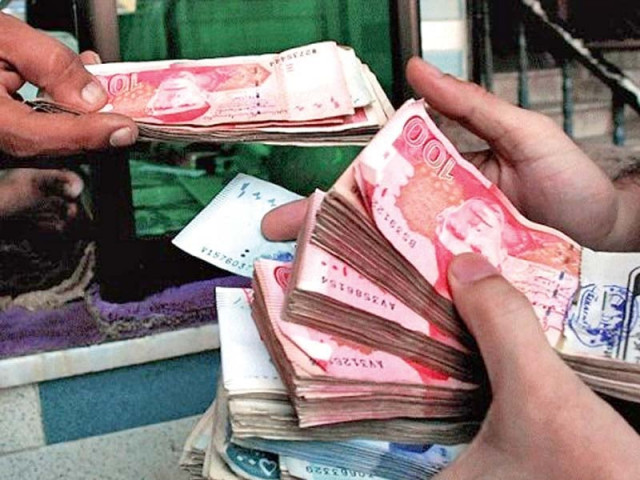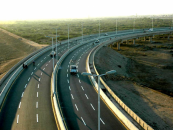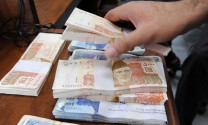Budget deficit jumps to Rs1.4tr
Debt servicing rises 15% in six-month period on back of increased borrowing

The federal budget deficit shot up to Rs1.4 trillion during first half of current fiscal year despite a tight control over expenditures, as the centre and provinces are set to meet this week under the banner of National Finance Commission (NFC).
The only main head of expenditure that remained out of control during the July-December period of current fiscal year was the debt servicing cost that jumped 15% to nearly Rs1.5 trillion, according to sources in the Ministry of Finance. The debt servicing cost has been on the rise due to burgeoning borrowing to fill the gap between expenditures and income.
The federal budget deficit stood at Rs1.4 trillion or 3.1% of gross domestic product (GDP), according to the sources. In terms of size of the economy, it remained at last year’s level but in absolute terms the deficit went up. For the current fiscal year, the government has set the federal budget deficit target at Rs3.43 trillion or 7.5% of GDP.
From July through December, the federal government obtained Rs1.2 trillion in loans - up by one-fifth - to finance the deficit that the federal government largely blames on the higher share of provinces under the NFC.
The maiden meeting of the NFC would be held in the Q-block on Thursday, to be chaired by Finance Minister Dr Abdul Hafeez Shaikh and is likely to be attended by all the provincial finance ministers.
During the meeting, the centre and provincial governments would share their fiscal positions in light of the new targets being discussed with the International Monetary Fund (IMF), said the sources.
The NFC decides the division of fiscal resources between the centre and provinces. There has been a deadlock between the centre and provinces over the new NFC award for the last six years.
The 7th NFC Award that had been unanimously agreed in 2010 expired in 2015 and is being extended every year by the president due to a lack of consensus on the 8th Award. There is increasing pressure on the provinces to give up part of their fiscal share or take additional expenditure responsibilities.
Despite transferring various functions to the provinces, the successive central governments have been financing health and education-related expenditures. The federal government also made parallel setups at the centre despite such functions resting with the provinces under the constitution.
Under the 7th NFC Award, the centre got 42.5% from the divisible pool. The remaining 57.5% share was distributed among the provinces on the basis of multiple formulae.
During the first half, the Federal Board of Revenue (FBR) collected Rs2.2 trillion in taxes and Rs1.3 trillion or 57.7% of the collection went to the provinces as their share in the taxes.
Gross federal receipts stood at Rs3.1 trillion, which increased 3.4% or Rs103 billion over the same period of previous year. After paying Rs1.3 trillion to the provinces, the net federal revenue amounted to Rs1.8 trillion, which was higher by 9%.
The net federal revenue fell short of the expenditure incurred on the two largest heads - debt servicing at Rs1.5 trillion and defence at Rs505 billion. Defence spending has remained less than the previous year.
The four federating units’ working capital stood at Rs213 billion, which was shown as provincial cash surplus. Overall, the total federal government expenditures increased 7% to Rs3.2 trillion during the July-December period. Expenses were higher by Rs205 billion compared to the same period of last year.
But the entire increase was on account of current expenditures, as development spending fell below last year’s level.
The government is exercising tight control over the development and defence spending, which has helped contain the deficit despite a significant surge in debt servicing cost.
The defence spending was lower in the first six months of current fiscal year as compared to the same period of last year, said the sources.
Defence spending stood at Rs505 billion, which was 4.7% or Rs25 billion less than the same period of previous fiscal year. The government has allocated Rs1.289 trillion for defence needs in the current fiscal year.
Development spending shrank 19% compared to the same period of last year. Under the Public Sector Development Programme (PSDP), provisional development spending remained at just Rs224 billion, Rs52 billion less than the same period of last fiscal year.
The spending worth Rs224 billion was only 34% of the annual development budget. The FBR received Rs2.2 trillion in taxes in the first half, up Rs124 billion or 6%. Non-tax revenue receipts decreased to Rs855 billion, 2.4% less than last year.
Primary balance, calculated after excluding interest payments, stood at Rs287 billion or 0.6% of GDP. The squeeze on development and defence spending is aimed at supporting the primary balance, which is part of the IMF’s conditions.
Published in The Express Tribune, February 3rd, 2021.
Like Business on Facebook, follow @TribuneBiz on Twitter to stay informed and join in the conversation.



















COMMENTS
Comments are moderated and generally will be posted if they are on-topic and not abusive.
For more information, please see our Comments FAQ